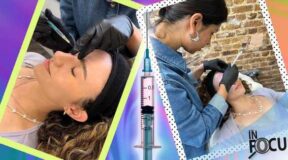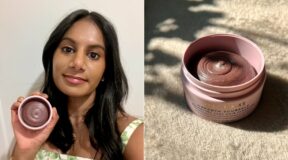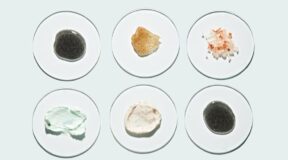The inner thighs and lower abdomen are two of the most difficult places to tone, even when a strict diet and exercise routine is being followed to the T. But a nonsurgical procedure, CoolSculpting, has made the promise to freeze off fat cells in tricky areas — with little to no recovery after.
Sound too good to be true? Well, we went to the pros to find out everything you need to know about this treatment — from how fast you'll see results to potential risks that come along with the procedure.
What Is Coolsculpting?
According to Heidi Waldorf, M.D., the Director of Laser and Cosmetic Dermatology at The Mount Sinai Hospital in New York City, CoolSculpting is the number one non-invasive body sculpting treatment in the entire world. Basically, the treatment, which is done using an FDA-cleared CoolSculpting device, uses cold to permanently destroy fat cells in a particular area. Unlike liposuction, no sedation is needed. Each treatment, our pro explains, reduces fat by about 20%.
Some 'tricky' areas that CoolSculpting is used to treat? "It can be used for double chin, upper arms, inner and outer thighs, knees, bra bulges, back fat, flanks and waist, and abdomen," Dr. Waldorf explains.
Who Is the Ideal Patient?
If you can pinch an inch of fat, Dr. Waldorf says you are a candidate for treatment. "The ideal patient is close to the weight he or she wants, but has bulges of fat that won't go away with exercise or diet," she explains. "Even patients who are in the process of losing weight or who just want to change their shape can be treated." (Some exceptions? CoolSculpting can not be used over an open hernia and it is not used for intraabdominal fat, she adds.)
How Does CoolSculpting Work?
The process begins with taking photographs and measurements of the desired area, Dr. Waldorf says. The applicator on the CoolSculpting device (chosen based on the size and shape of the area) is then attached to the area of unwanted fat, she explains. There may also be suction involved depending on the area that's being targeted.
When it's time for application, the cold temperature is activated and is automatically adjusted accordingly to your body. The extreme cold temperatures cause the fat cells to freeze, crystalize, and then die, explains Washington D.C.-based plastic surgeon Troy Pittman, M.D. Your body's immune system should clear away the cellular debris (a.k.a. the dead fat cells) leaving you with less fat in the treated area.
Dr. Waldorf adds that the treatment usually takes about 35 minutes, with the exception of the "CoolSmooth" for the outer thighs, which takes 75 minutes. She adds that following CoolSculpting, "the area is either manually massaged or treated with radiowaves to break up the crystals," she says. (Dr. Waldorf says her office uses a separate machine called the Zimmer ZWave Pro, to penetrate the skin, break up crystals, reduce swelling, and speed up the resorption of fat.)
Typically there's no downtime, though patients may experience some temporary redness or bruising at the site, according to Dr. Pittman, which typically goes away several days after the procedure.
How Long Does It Take to See Results?
Dr. Waldorf notes that you should begin to see results within about a month or so, but not to expect the full effect until after three months. The number of treatments required depends completely on each patient and their goals, says Dr. Pittman. Some may need one treatment, while others need two to four to see results, he adds.
How Much Does It Cost?
The price greatly depends on where you're receiving the treatment and how many cycles you need. But according to Dyer, it usually starts around $750 per cycle or $1500/area. She listed both flanks (the areas around the sides of your body from your upper abdomen to your back) or both thighs as an example of what is considered an area.
Are CoolSculpting Results Permanent?
Laura Dyer, a top board-certified physician assistant at the office of Amy Wechsler, M.D., says the results of CoolSculpting are typically extremely long-lasting.
A quick lesson on fat cells: "After puberty, the stem cell capabilities that allowed fat cells to reproduce turn off, so the number of fat cells you have at age 18 is typically the number of fat cells you die with," she says. "Over the course of your life, as you gain or lose weight, those fat cells either expand or contract — but the number of them never changes." CoolSculpting however targets the actual number of fat cells. "Once your fat cells are exposed to CoolSculpting, 20-25% of them solidify, freeze, and then die during the course of the treatment. It takes your body about three months to fully dispose of the treated fat cells but once they are gone, they are gone for good and will not return."
Important caveat: While those original fat cells are gone forever, the treatment does not of course, protect against future weight gain, so any of the remaining fat cells can expand and get bigger, according to Dr. Pittman.
VIDEO: 8 Healthy Ways to Lose Belly Fat, According to Science
Is CoolSculpting Safe?
Although rare, there is a condition known as paradoxical adipose hyperplasia (PAH), which essentially means that following treatment, an abnormal growth (also known as hypertrophy) of fat cells is triggered due to the stress from the procedure, says Dr. Pittman.
"Rather than the fat cells dying and going away, the fat cell gets larger," he explains. "Patients who have experienced PAH after this procedure cite weight gain and disproportionate fat growth in the area treated." So basically the opposite of what you were trying to achieve.
He adds that it's more common to happen with old, outdated devices, and in the lower abdomen area. Despite the low chance, it appears the percentage of reported cases of PAH has increased, from 1 in 20,000 to 1 in 2,000, according to Dr. Pittman. A 2021 study printed in the Aesthetic Surgery Journal, suggests that the incident rate is 1 in 4,000 cycles and that rates dropped by over 75% with new models.
All in all, the risk of developing PAH is small, but it does require surgical treatment and can cause significant distress, so it's worth being aware of. Options that don't come with the risk of PAH attached include surgical liposuction or TruSculptID by Cuter, which uses radiofrequency energy to kill fat cells by heating them, Dr. Pittman explains.
Is CoolSculpting Worth It?
While PAH is rare, Dr. Pittman notes that there is no way to tell who will develop the condition ahead of time, so receiving the treatment is a bit of a gamble. At the end of the day, it's up to the patient to decide whether or not any treatment is worth the risks and money, but as for CoolSculpting, Dr. Pittman notes if you're happy with a "modest result," it can be a solid nonsurgical option that requires little to no downtime for those who don't want to go under the knife.
Source: Read Full Article







